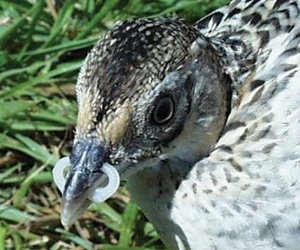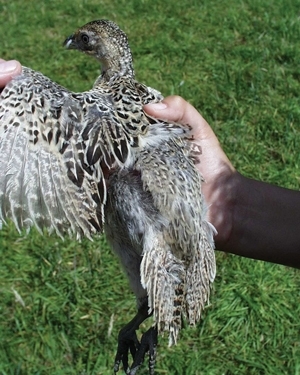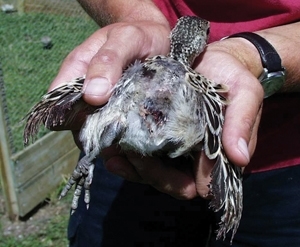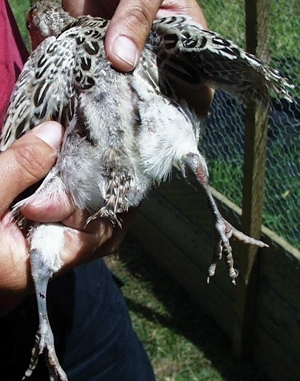Key findings
- Mortality is higher in flocks of unbitted pheasants because of increased feather pecking.
- Feather pecking constitutes a welfare problem in gamebird flocks.
- Food consumption among bitted birds is similar to that in non-bitted birds.
 Pheasant with bit in situ and due for removal. (Des Purdy)
Pheasant with bit in situ and due for removal. (Des Purdy)
Gamebirds reared in captivity, in common with most poultry, are prone to the vices of feather pecking and cannibalism. The poultry industry attempts to control this by a variety of means varying from long-term breeding policies to short-term remedies such as beak cautery. Environmental enrichment techniques have been tried in both gamebird and poultry rearing with limited success. Even in extensive (free range) poultry systems, feather pecking and cannibalism are major causes of mortality and are important welfare issues.
In gamebird rearing, fitting small plastic bits into the beaks of the pheasants for a period of three to four weeks during the early rearing period usually prevents feather pecking and cannibalism. Bits are removed before the birds’ release at six to seven weeks old.

A bird from a bitted group at five and a half weeks old with feather score 5 (good overall feathering).
Note the plastic bit fitted into the nares. (Des Purdy)
Although pen enrichment techniques are to be encouraged, they don’t always prevent feather pecking and cannibalism. Beak trimming, apart from any welfare concerns, is no longer considered acceptable in gamebirds as they need to be released into the wild with their beaks intact. Long-term breeding policies similar to those used in poultry are likely to lead to a loss of ‘wildness’, which would be counter-productive for a gamebird.
Most game rearers would prefer not to bit birds routinely as the operation is time-consuming. But to leave the birds unbitted and bit as required would expose them to outbreaks of feather pecking, which would be difficult to stop. However, there has been little research to support this view.
To rectify this, we conducted a study with the Game Farmers’ Association across a range of facilities. Each farm had bitted and unbitted birds. Birds were bitted at the normal or at a nominal three weeks old and, apart from the bit, other management was the same for both groups. If feather pecking became a welfare problem in any unbitted group, there was the facility to bit the affected birds to minimise this.
 Unbitted bird at five and a half week.
Unbitted bird at five and a half week.
Note the bare back and bleeding from tail blood quills. (Des Purdy)
We found that all the bitted birds maintained good feather condition throughout the study, whereas the condition of the unbitted birds deteriorated in all cases where feather pecking was evident. In five out of seven cases the condition of the ‘unbitted’ birds deteriorated so much that they had to be bitted on welfare grounds. At all sites, feather pecking adversely affected the welfare of the birds. Six of the seven farms (one did not comment) considered the non-bitted birds unfit for release, as they would have been liable to chilling in bad weather.
Five farms provided data on mortality, four of which showed an increase in mortality in the non-bitted birds. The exception showed an increase in mortality in the bitted birds, but this was associated with an outbreak of hexamitiasis. Two of the three farms where body weight was measured demonstrated a weight advantage in favour of the bitted birds. This was reversed in the third farm possibly owing to hexamitiasis. Of the sites where it was measured, there was little difference in food consumption.
In further studies we have shown that where feather pecking does not occur, bitted birds perform as well as unbitted ones.
 Unbitted bird at five and a half weeks.
Unbitted bird at five and a half weeks.
Note the bare back, absence of tail and lesions on hock and tarsal areas. (Des Purdy)
Get the Latest News & Advice
Join over 100,000 subscribers and stay updated on our latest advice, research, news and offers.
*You may change your mind any time. For more information, see our Privacy Policy.